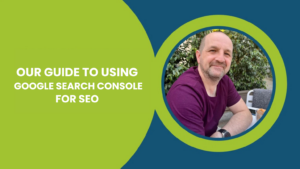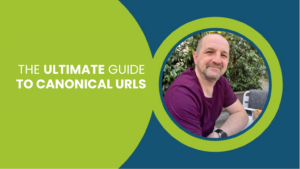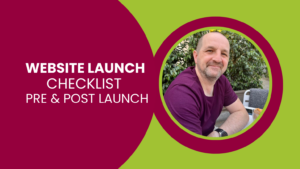Prospective students have a big choice to make when it comes to deciding on a path for higher education. For most, their decision-making process begins with a simple web search as they weigh up their options when searching for both colleges and universities. Naturally, when they’re searching, you will want your website to appear in the top results – allowing you to showcase your institution, course details, and what life is like there.
SEO for Higher Education is very important as it will help you bring those curious soon-to-be students to your website; allowing them to discover more about your institution. In this blog, we’ll dive into five important tips to consider to boost SEO for higher education websites and bring more traffic to your site than ever before.
What is SEO, and why is it important for Higher Education?
SEO, or search engine optimisation, refers to the process of optimising digital content to improve its visibility and ranking in search engine results. Search engine optimization (SEO) holds a crucial position for higher education institutions seeking to expand their online presence. A well-structured SEO strategy can significantly impact an institution’s visibility and digital reputation, directly influencing its ability to attract prospective students and engage with a wider audience.
First and foremost, SEO serves as the fundamental bridge between the educational institution and potential students actively searching for relevant academic programs and educational resources. By optimising web content, including website structure, meta descriptions, and keywords, institutions can ensure that their offerings rank higher in search engine results, making them more accessible and appealing to the target audience.
Moreover, in an era where the majority of the student population relies heavily on online research and resources during their decision-making process, the significance of appearing prominently in search results cannot be overstated. High visibility in search engine rankings not only fosters a sense of credibility and reliability but also significantly increases the likelihood of capturing the attention of prospective students who are actively seeking reliable and reputable educational institutions.
A robust SEO strategy can contribute to establishing a competitive edge for the institution within the higher education landscape. By implementing tailored SEO techniques, institutions can differentiate themselves from competitors, effectively highlighting their unique value propositions, specialised programs, and cutting-edge research initiatives.
Recent SEO Blog Posts
Benefits of SEO for Higher Education Institutions
- Increased Visibility: Higher search rankings raise institutional visibility, fostering brand recognition.
- Targeted Reach: Tailored content attracts relevant audiences, boosting enrollment prospects.
- Cost Efficiency: SEO reduces reliance on costly ads, providing cost-effective marketing.
- Enrollment Boost: Prospective students easily access program details, potentially increasing enrollment.
- Credibility: High rankings enhance credibility, building trust with users.
- Data Insights: SEO metrics offer valuable insights for refining strategies.
- Global Outreach: International students are reached through multilingual optimization.
- Long-Term Impact: Well-optimized content attracts sustained organic traffic.
- Competitive Edge: SEO outperformance can establish institutions as top choices.
- Cross-Departmental Benefits: SEO aids admissions, research, and community engagement.
The Impact of SEO on Higher Education Enrolment
Search engine optimization (SEO) has revolutionized how higher education institutions attract and engage prospective students. By ensuring that relevant program information is easily discoverable, SEO enhances the enrollment journey. Prospective students can quickly access details about courses, admission requirements, campus facilities, and more. This streamlined access not only simplifies the decision-making process but also encourages higher enrollment rates. Well-executed SEO strategies position institutions as credible and trustworthy sources of education, increasing their appeal to a wider audience. As a result, SEO’s impact on higher education enrollment is a profound one, shaping the future of institutions and the students they serve.
The importance of SEO in attracting prospective students to higher education institutions.
With more prospective students turning to search engines to explore their academic options, understanding the significance of SEO in this context is crucial. In this section, we’ll delve into why SEO is essential for attracting prospective students to higher education institutions and provide valuable tips for maximizing its impact.
Popular Education Marketing Videos
Popular Education Marketing Videos
Visibility in the Digital Landscape
Prospective students rely heavily on search engines like Google to discover and research higher education institutions. A strong SEO strategy ensures that your institution’s website ranks prominently in search results when relevant queries are entered. This increased visibility can significantly enhance your institution’s chances of being noticed by potential students.
Building Credibility and Trust
High search engine rankings often equate to credibility and trustworthiness in the eyes of users. When your institution’s website appears at the top of search results, it signals to prospective students that you are a reputable and authoritative source in the field of education. This can be a critical factor in their decision-making process.
Cost-Effective Marketing
Compared to traditional marketing channels, such as print advertising or billboards, SEO is a cost-effective way to reach a vast audience. It allows you to target specific keywords and demographics, ensuring that your efforts are focused on attracting students who are genuinely interested in your programs.
Understanding User Intent
A well-optimized website not only ranks well but also aligns with the intent of the users. By analyzing search queries, you can gain insights into what prospective students are looking for and tailor your content to meet their needs. This user-centric approach can lead to higher engagement and conversions.
Competitive Advantage
Higher education is a competitive industry, and SEO can give your institution a competitive edge. By outperforming your competitors in search rankings, you can attract students who might have otherwise chosen a different institution.
Enhanced User Experience
SEO involves optimizing various aspects of your website, including its design, content, and structure. This optimization process can significantly improve the user experience, making it easier for prospective students to navigate your site, find relevant information, and complete desired actions, such as submitting an application or contacting admissions.
Get Your Personal Google Ads Audit Video
Please provide your details below and one of our specialists will be in touch as soon as possible.
Strategies to Improve SEO for Higher Education Websites
1. Keep your Higher Education Website tidy
At the centre of every great higher education SEO strategy is an air-tight website. The best place to start is by auditing your website’s technical SEO health. While by no means exciting, this is perhaps the most crucial step in your SEO optimisation journey.
By taking a look under the bonnet, you’ll be able to identify anything that might inhibit the user experience or prevent search engines from effectively crawling and indexing your website. If it’s revealed that your site has a lot of technical errors such as broken links, it will get penalised and will not appear in the top search results (even if it deserves to).
Tools such as SEMrush’s Site Audit will help highlight these errors and speed up the process of fixing them!
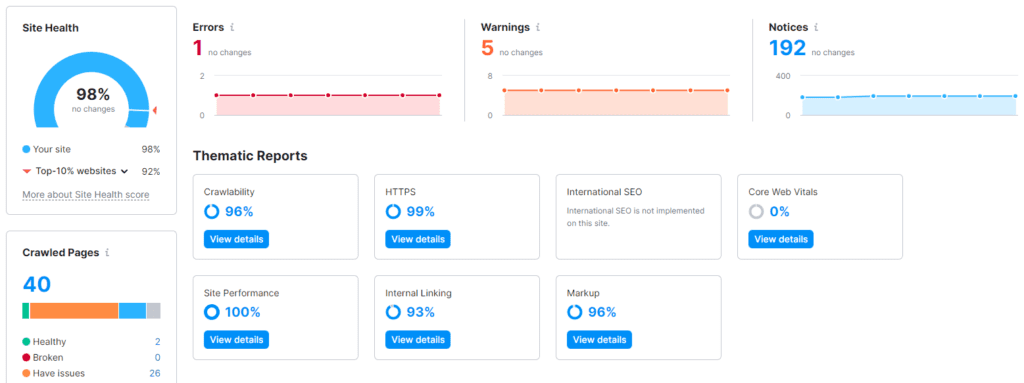
Here’s an example of the things you need to look for in your audit:
- Metadata – optimise the length of your meta titles and descriptions. Reduce any duplicates and ensure that none are missing.
- Broken links
- Page speed
- 404 pages errors
- Pages with too much duplicate content
- Titles and alt text for your images.
This list is not exhaustive, and getting all of these things right can be a lengthy technical process. It would be very beneficial to consult SEO agencies for higher education to assist with this!
2. Use Keywords Effectively for Higher Education SEO
A marketer’s best friend and nemesis, usage of the right keywords is incredibly important in creating high-ranking pages for your website. They are your ticket into search engine results and are what prospective students will enter into search engines to discover your, or your competitors’, courses.
As such, ensuring correct usage across all of your pages is a necessity for increasing a website’s ranking on search engine results. Ensure that you undertake keyword research when it comes to updating your pages and try to feature 5-10 on each.
As part of your content strategy, a great idea is to start with some keyword research. You can then use your findings to create blogs based on a target keyword with the correct intent. For instance, having a blog for the keyword term ‘largest universities UK’ will allow you to deliver high-ranking, valuable content to prospective students that will answer their questions and assist you in presenting your institution as an option for them (if applicable).
If you have a Google Ads account, you can take advantage of the Keyword Planner tool to research the keywords that you could target.
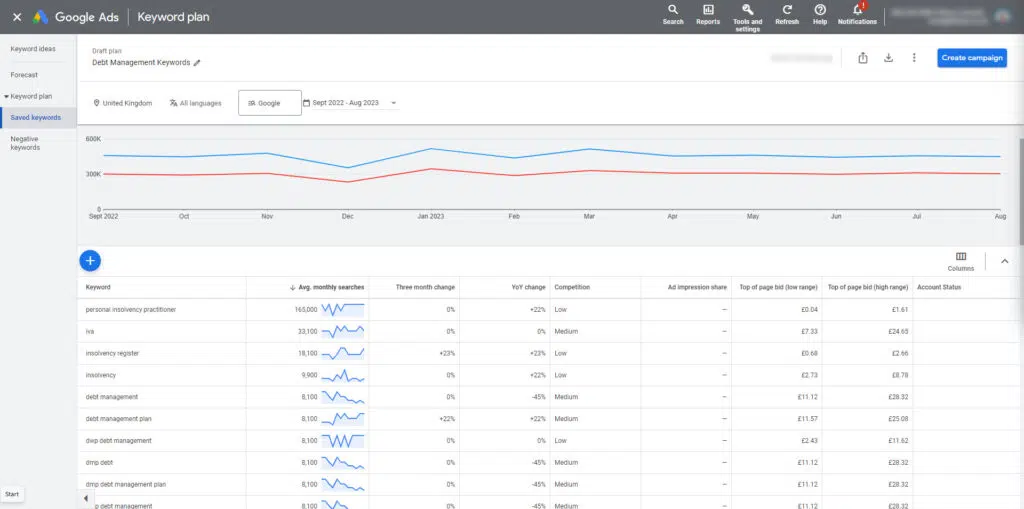
3. Assess and Update your Current Content
Following on from the previous point, ask yourself these questions:
- Exactly what information are your prospects looking for?
- What is your site currently ranking for?
- What pages are bringing the most traffic to your website? Why?
- If you can’t answer these questions, then it’s time to knuckle down and look into the analytics.
Aligning your content with what your audience is looking for and optimising its delivery is the core of maintaining any successful website.
Leverage and master tools such as Semrush and Google Search Console to gain full knowledge of what pages and keywords are performing the best. Marry this up with the ‘why’ by analysing keyword trends and what terms to use are essential in the highly competitive, modern digital landscape.
Content is key, optimising your images with alt tags etc will help your page rank on search engines. Video is also an extremely powerful tool and Google is looking out for great quality video content to help your website visitors.
4. Take a Mobile First Approach
Mobile traffic accounts for over half of the web traffic worldwide, and this will likely keep increasing. Optimizing your site for a mobile user experience not only improves your ranking but is also fundamental to ensuring a consistent, seamless, and high-quality mobile experience. It’s always worth remembering that your target audience is late teens and early adults. Research has consistently shown that 16-24-year-olds use mobile as part of their search results therefore their search terms will differ. It is only natural that they are more likely to be using a mobile device to access your website. When you undertake your site audit, you’ll soon notice that quality scores are separated between mobile and desktop with mobile being typically more difficult. Don’t neglect this – site and page speed have an impact on search engine ranking for both desktop and mobile. Slow site/page speeds mean that search engines can’t crawl your pages effectively and will ultimately harm your SEO. Prioritise improving your speeds as this will help improve your user experience and increase conversions.
5. Refine Website Architecture for Higher Education SEO
Aside from creating the best experience for your users, great site architecture is something that search engines look for. A disorganized and convoluted site architecture will be harder for crawlers to work through, resulting in your pages and even your site ranking being lower. Nobody wants to work hard in creating great campaigns and activities to push relevant traffic to their website, only to have them leave in frustration at a site that’s difficult to use. Some core ways to improve your architecture include: creating a simple and clear top-level navigation menu; implementing a pillar-cluster internal linking model, and providing access to the majority of your website’s pages in 3-4 clicks. It’s a good idea to have a look at what industry leaders are doing in terms of site architecture so you can learn what has helped them rank higher. If you require a restructuring, outsourcing this to agencies that specialise in education websites is a fantastic idea.
6. Conduct a link-building strategy
Link-building plays a vital role in boosting the online credibility of higher education institutions. Creating valuable and shareable content, such as research papers and insightful blog posts, encourages reputable websites to link back to your content. Building partnerships with other institutions and industry leaders also fosters natural link-building opportunities. Leveraging tools like SEMrush, which offers backlink analysis, competitive research, and link-building capabilities, can streamline the process. By implementing a robust link-building strategy and utilizing SEMrush, institutions can strengthen their online influence, elevate search engine rankings, and establish themselves as authoritative voices within the academic community and beyond.
7. Optimise Videos and Images
Optimising videos and images is crucial for enhancing the online presence of higher education institutions. Implementing descriptive and keyword-rich file names, alt tags, and captions for images, along with providing transcripts and relevant metadata for videos, can significantly improve their visibility in search results. Utilising tools such as SEMrush, which offers insights into image and video SEO, enables institutions to optimize multimedia content effectively. By prioritising the optimisation of videos and images, institutions can enhance their online visibility, engage a wider audience, and effectively showcase their educational offerings in a visually appealing and accessible manner.
8. Audit and Update Existing Content
Regularly auditing and updating existing content is essential for maintaining the relevance and competitiveness of higher education institutions. Conducting comprehensive content audits to identify outdated information, broken links, and SEO optimization opportunities allows institutions to enhance the quality and visibility of their online resources. Leveraging tools like SEMrush, which provides content audit features and suggestions for improving content performance, can streamline this process. By prioritizing the regular audit and update of existing content, institutions can ensure that their online materials remain accurate, informative, and highly discoverable, contributing to sustained engagement and a strong digital presence within the educational landscape. Case Studies: Successful SEO Implementation in Higher Education
How to measure the effectiveness of your SEO strategy?
When it comes to measuring the success of your SEO strategy for your higher education institution, there are a few simple ways to check if it’s having the desired impact. Start by looking at how many people are visiting your website through organically search engines. More visitors generally mean your content is showing up higher in search results. You can do this either using Google Search Console, or Google Analytics.

potential students are using to find your institution online. If these words are relevant and lead people to your site, it’s a good sign your SEO is effective. On top of this make sure to track your keyword progress for those terms you are looking to rank in SERPs for. SEMrush has a position tracking tool that allows you to see all of your chosen keywords in one place, or you could also do it manually but looking in SERPs.
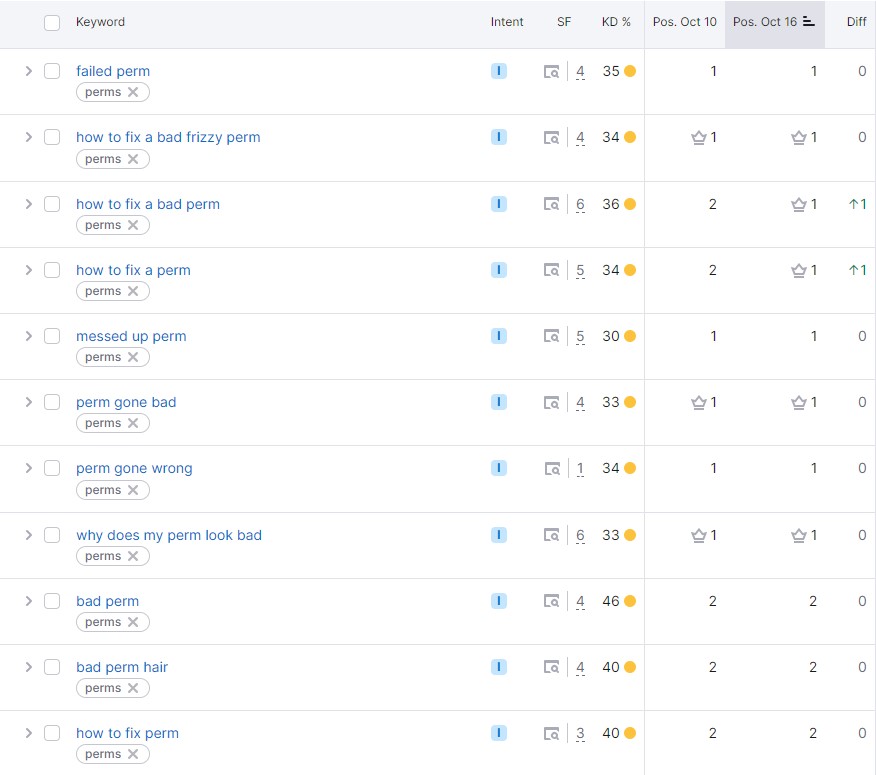
You can also assess the quality and quantity of other reputable websites linking back to yours, which is also known as baclinking. This indicates that others recognize your institution as a reliable source of information, which is a positive sign for your SEO efforts. Using SEMrush’s backlink audit tool you can view those sites linking to you, and even disavow/block sites that may be spammy.
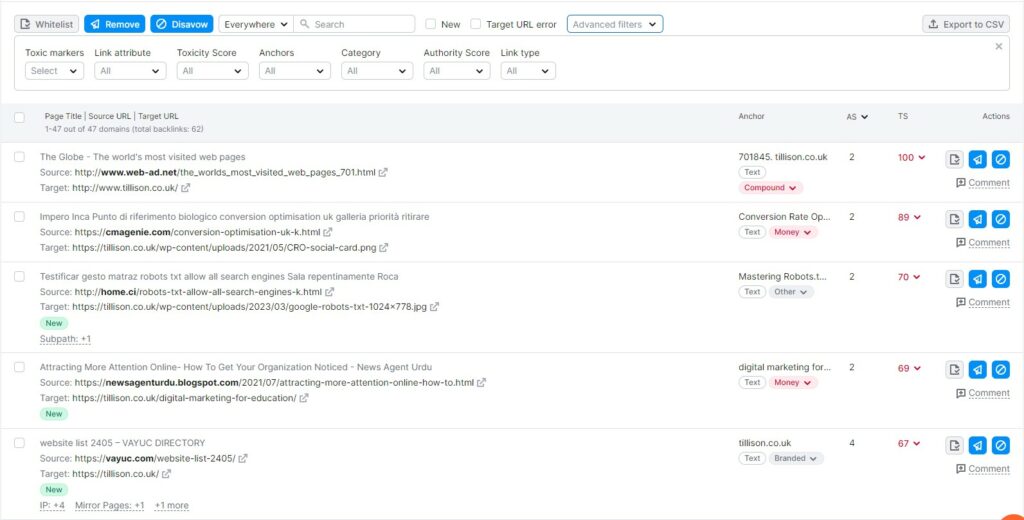
Leverage tools like Google Analytics, Google Search Console, and SEMrush. These tools can provide valuable data on your website’s performance, including keyword rankings, click-through rates, and backlink profiles. Regularly assessing these metrics through these tools will provide a comprehensive understanding of how your SEO strategy is influencing your institution’s online visibility and engagement with potential students. Adjusting your strategy based on these insights can help you maintain a strong online presence and ensure continued success in reaching your target audience effectively.
Challenges in Implementing SEO Strategies for Higher Education
Search engine optimization (SEO) has become a pivotal aspect of any organization’s online presence, including higher education institutions. However, the unique nature of the higher education landscape presents its own set of challenges when it comes to effectively implementing SEO strategies. Let’s delve into some of the key hurdles that higher education institutions often face:
Highly Competitive Landscape:
The realm of higher education is fiercely competitive. With numerous universities and colleges vying for the attention of prospective students, ranking higher in search engine results pages (SERPs) is crucial. This intense competition makes it difficult to secure top positions for relevant keywords, requiring institutions to employ innovative strategies to stand out.
Complex Website Structures:
University websites tend to be expansive, with multiple departments, programs, research centers, and administrative sections. This complexity can lead to convoluted website structures that hinder search engine crawlers from effectively indexing and ranking pages. Ensuring a coherent and organized site structure that caters to both users and search engines is a constant challenge.
Diverse Target Audiences:
Higher education institutions cater to a wide range of audiences, including prospective students, current students, parents, faculty, researchers, alumni, and even potential donors. Crafting SEO strategies that address the diverse needs and search behaviours of these audiences requires careful planning and segmentation.
Ever-Changing Algorithms:
Search engines frequently update their algorithms to enhance user experience and deliver more accurate results. Staying abreast of these changes and adjusting SEO strategies accordingly demands a continuous effort. What works today might not yield the same results tomorrow, necessitating constant adaptation.
Content Quality and Relevance:
Producing high-quality and relevant content is paramount for SEO success. In the context of higher education, striking a balance between academic rigour and accessible content can be challenging. Furthermore, keeping educational content up-to-date while adhering to SEO best practices requires a delicate approach.
Local and Global Considerations:
Higher education institutions often target both local and international audiences. Balancing local SEO efforts, such as promoting campus events or local partnerships, with global SEO strategies can be intricate. Effective geo-targeting is essential to ensure that the right audiences are reached with the appropriate content.
Limited Resources:
Many higher education institutions face budget and resource constraints. SEO campaigns require dedicated personnel, tools, and time to execute effectively. Allocating these resources while managing other institutional responsibilities can be a juggling act.
Conclusion
Implementing a robust SEO strategy is crucial for higher education institutions aiming to attract and engage prospective students effectively. By prioritizing visibility, credibility, and user experience, institutions can position themselves as top choices for students exploring their academic options. Understanding the importance of SEO and its role in the digital landscape can empower institutions to create tailored strategies that resonate with their target audience, driving enrollment and fostering long-term success.
FAQs
SEO in higher education refers to the process of optimising websites and online content to increase the visibility and traffic of a higher education institution’s website in search engine results pages (SERPs).
SEO is important for higher education institutions because it helps them attract prospective students, faculty, and staff, as well as engage with current students, alumni, and donors. SEO can help institutions rank higher in search engine results for relevant keywords and phrases, making it easier for people to find and learn about the institution.
Some best practices for SEO in higher education include conducting keyword research to identify relevant keywords and phrases, optimising website content and structure, using metadata and tags to help search engines understand the content on a page, building high-quality backlinks from reputable sources, and regularly monitoring and analysing website traffic and search engine rankings.
Higher education institutions can measure the success of their SEO efforts by tracking website traffic, search engine rankings, and conversions (such as inquiries or applications). They can also use tools like Google Analytics and Google Search Console to monitor website performance and identify areas for improvement.
Some common mistakes to avoid when implementing SEO in higher education include keyword stuffing, using irrelevant or low-quality backlinks, neglecting mobile optimisation, and failing to regularly update website content. Institutions should also avoid using deceptive or unethical SEO practices, which can result in penalties from search engines. Improve your University’s SEO Today


